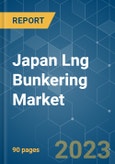The Japan LNG bunkering market is expected to grow at a CAGR of more than 5.25% during the forecast period.
The market was negatively impacted by the COVID-19 pandemic, as demand for LNG bunkering services fell as marine shipping and trade declined significantly. However, the market has since rebounded and is expected to grow steadily during the forecast period.
This product will be delivered within 2 business days.
The market was negatively impacted by the COVID-19 pandemic, as demand for LNG bunkering services fell as marine shipping and trade declined significantly. However, the market has since rebounded and is expected to grow steadily during the forecast period.
Key Highlights
- Over the long term, factors such as rising investments in LNG bunkering infrastructure and facilities are expected to drive the market during the forecast period.
- On the flip side, the increasing adoption of alternative low-sulfur fuels such as Marine Gas Oil (MGO) and Low-Sulfur Fuel Oil (LSFO) is expected to restrain the market during the forecast period.
- Nevertheless, rising investments in small-scale LNG infrastructure are expected to provide a significant opportunity for the market beyond the forecast period.
Japan LNG Bunkering Market Trends
Tanker Fleet to Dominate the Market
- The tanker fleet stores or transports gases or liquids in bulk amounts. These tanker fleets store and carry oil, chemicals, gas, and other products, like vegetable oil, fresh water, wine, molasses, etc.
- Japan is an island nation that relies heavily on imports, mainly energy imports, to fuel its economy. During 2021, Japan's primary energy consumption stood at 17.74 exajoules. Despite energy consumption falling during the last decade, as Japan has reduced the share of nuclear energy in its primary energy mix, the demand for low-carbon energy sources for reducing emissions has grown significantly.
- Major LNG-producing nations, such as the United States, Australia, and Qatar, are primarily transported by large tankers. Due to heavy dependence on LNG imports for its energy requirements, the tanker fleet segment is expected to dominate the Japan LNG bunkering market during the forecast period.
- Tankers using standard fuel oils and diesel fleets must use marine scrubbers. According to the IMO 2020, since 1st January 2020, all marine vessels have had to shift to low-sulfur fuel or LNG. With the regulations related to sulfur content in fuel, LNG is projected to become a reliant fuel in the coming years for tankers.
- Hence, the increasing number of tanker fleets is expected to drive the demand for LNG-fueled fleets over the forecast period.
Development of LNG Bunkering Facilities to Drive the Market
- Japan has been one of the pioneer countries in the development of LNG bunkering facilities. Increasing the number of LNG-propelled vessels significantly requires a network of LNG bunkering facilities.
- Japan is one of the largest LNG importers globally, and in 2021, Japan imported nearly 101.3 Billion Cubic meters (Bcm) of LNG. Though LNG imports have been falling over the last decade, Japan still imports large volumes of LNG. As the country tries to decarbonize its marine shipping sector, demand for LNG bunkering services is expected to rise significantly.
- Japan is one of the global leaders in LNG bunkering services, and several companies are involved in providing LNG bunkering services across Japanese ports. In January 2023, Mitsui O.S.K. Lines signed basic agreements with Japan Petroleum Exploration (JAPEX) and Hokkaido Gas to supply LNG to two new LNG-fuelled ferries.
- Previously, in February 2022, Mitsui O.S.K. Lines, Ltd signed a deal with Naikai Zosen to construct the two LNG-fuelled ferries that will replace two ships (the Sunflower Daisetsu and Sunflower Shiretoko) with LNG fuel supply scheduled to start in 2025 when the vessels enter service.
- In March 2022, a consortium of Kyushu Electric Power Co., Inc., NYK Line, Itochu ENEX Co. Ltd, and Saibu Gas Co. Ltd established a joint venture company, KEYS Bunkering West Japan Co., Ltd., and have announced plans to start the operation of the LNG fuel supply business for ships in Japan’s Kyushu and Setouchi regions in the spring of 2024. The consortium has also awarded a shipbuilding contract for one private vessel for the supply of LNG fuel to ship to Mitsubishi Shipbuilding Co., Ltd
- Hence, such developments are expected to drive the LNG bunkering market in Japan during the forecast period.
Japan LNG Bunkering Market Competitor Analysis
The Japan LNG bunkering market is moderately consolidated. Some key players in this market (in no particular order) include Kawasaki Heavy Industries, Ltd., Central LNG Marine Fuel Japan Corporation, Toyota Tsusho Corporation, Mitsui OSK Lines Ltd, and Nippon Yusen Kabushiki Kaisha., among others.Additional benefits of purchasing the report:
- The market estimate (ME) sheet in Excel format
- 3 months of analyst support
This product will be delivered within 2 business days.
Table of Contents
1 INTRODUCTION
4 MARKET OVERVIEW
5 MARKET SEGMENTATION
6 COMPETITIVE LANDSCAPE
Companies Mentioned (Partial List)
A selection of companies mentioned in this report includes, but is not limited to:
- Kawasaki Heavy Industries, Ltd.
- Central LNG Marine Fuel Japan Corporation
- Toyota Tsusho Corporation
- Mitsui OSK Lines Ltd
- Nippon Yusen Kabushiki Kaisha
- Chubu Electric Power Co., Inc.
- Engie SA
Methodology

LOADING...










